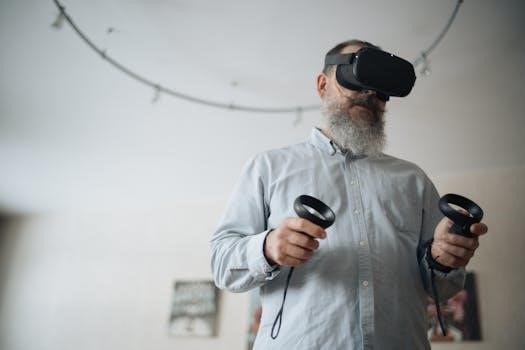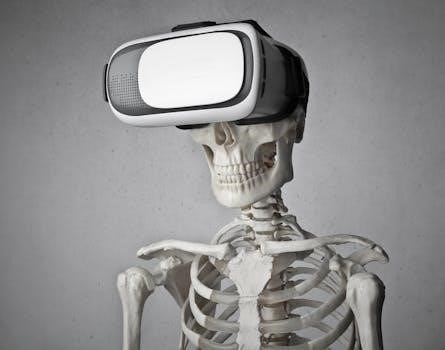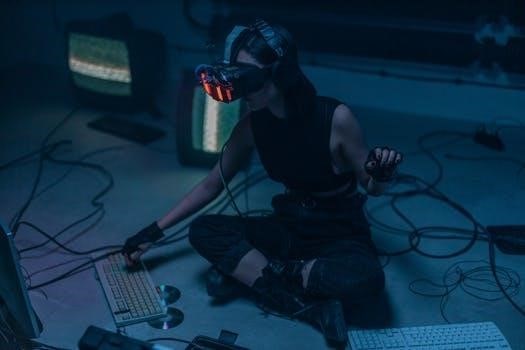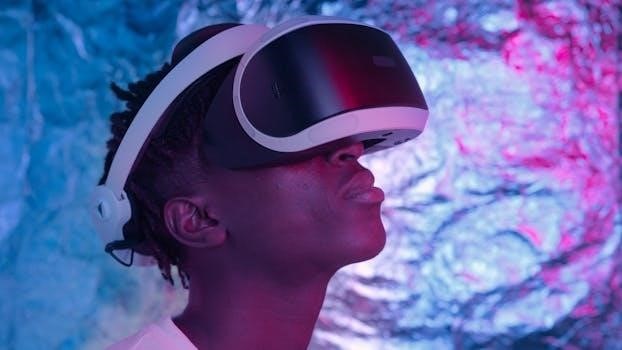Jean Baudrillard’s Simulacra and Simulation, a philosophical treatise from 1981, explores how models generate a hyperreal world, where the map precedes the territory. This work delves into simulation’s impact on culture and reality.
Overview of Baudrillard’s Work
Jean Baudrillard, a prominent postmodern philosopher, is renowned for his incisive analysis of contemporary society, particularly his exploration of simulation and simulacra. His work, including the seminal text Simulacra and Simulation, challenges conventional understandings of reality, representation, and the role of mass media. Baudrillard argues that we increasingly inhabit a world dominated by signs and models that have detached from any underlying reality, creating a hyperreality that often obscures truth. Through his writings, he interrogates how media constructs artificial worlds that are often perceived as more real than reality itself. He examines the impact of consumer culture, technological advancements, and communication on shaping our perceptions, emphasizing the ways in which simulations become replacements for original experiences and genuine interactions. He also delves into the concept of the precession of simulacra, where representations precede and determine reality, leading to a loss of authenticity and the blurring of boundaries between what is real and what is simulated. Baudrillard’s insightful and thought-provoking theories continue to be highly influential in media studies, sociology, and cultural criticism.

Key Concepts in Simulacra and Simulation
Baudrillard’s work introduces key concepts⁚ simulacra, copies without originals; simulation, the generation of the hyperreal; and hyperreality, where models precede and define reality, obscuring truth.
The Concept of Simulacra
In Jean Baudrillard’s framework, simulacra are not mere copies but rather signs or representations that have detached from any original referent. These are not imitations of reality but stand-alone entities that have become self-referential. Unlike traditional representations that point back to something real, simulacra exist in a state of pretense, often masking the absence of a true original. They operate within a closed system of signs, creating a self-sustaining world of representations. Baudrillard suggests that with the proliferation of mass media and technology, simulacra have become increasingly dominant, leading to a blurring of the lines between reality and representation. This constant bombardment of images and symbols can lead to a sense of detachment from the real world as we increasingly interact with these manufactured illusions. The concept of the simulacrum is crucial for understanding the broader concept of simulation.
The Concept of Simulation
Simulation, in Baudrillard’s analysis, is a process where models generate a real without origin or reality, creating what he calls the hyperreal. It’s not about representing something that exists; rather, it’s about generating a real from models, where the map precedes the territory. This process involves the creation of simulacra, which then become the basis for our understanding of reality. Simulation blurs the distinction between the real and the artificial, making it difficult to discern what’s authentic and what’s manufactured. It’s a system where signs no longer refer to any original but only to other signs. This shift indicates a move from representation to simulation, where the very idea of an original reality is lost. The dominance of simulation leads to a state where the manufactured and the real are indistinguishable, fundamentally altering our experience of the world.
Hyperreality Defined
Hyperreality, as defined by Baudrillard, is a state where the simulation of reality becomes more real than reality itself. It’s a condition where signs no longer refer to an external reality but only to each other, creating a self-referential system. In hyperreality, the distinction between the real and the simulated collapses, and the simulated becomes the new real. This is not just about false representation; it’s about the disappearance of the real behind its simulation. It’s a condition where our experiences are mediated through models and simulations that are more compelling and engaging than the world outside. Hyperreality is the culmination of the simulation process, where the lines between genuine experience and its manufactured counterpart become indistinguishable. The hyperreal environment is one where our perceptions are so saturated with simulations that we lose the capacity to differentiate the real from its copies.

The Precession of Simulacra
The precession of simulacra describes how simulations precede and determine reality, where the map comes before the territory, and the simulated becomes more real than the real.
Map Preceding Territory
Baudrillard introduces the concept of the “map preceding territory,” a radical reversal of traditional understanding. This signifies a shift where representations or models (the “map”) no longer reflect an existing reality (the “territory”) but rather precede and generate it. In this framework, the map is not a secondary depiction, but the primary force shaping our experience. Simulations and models become the basis upon which reality is constructed. This idea challenges the conventional notion of a direct relationship between a representation and what it represents. Instead, the map, through its hyperreality, becomes more real than the territory it was meant to depict. This transformation leads to a world saturated with simulacra, where the original is lost and replaced by its copies, and the models become the framework of our lives, effectively creating a reality that is entirely simulated, challenging our perception of what is authentic and what is not.
The Generation of the Hyperreal
The hyperreal emerges when simulation replaces reality, creating a realm where the distinction between the real and the artificial blurs. This is not merely a distortion of reality, but the generation of a new reality through models. In this process, the signs and symbols that once represented reality become detached from their referents, instead referring only to each other. As these signs proliferate, they form a self-referential system, creating a hyperreality that is more real than the real itself. This hyperreality is not a false representation, but a new kind of real, constructed by simulations. Mass media plays a significant role in this process, saturating the environment with images and representations that contribute to the generation of a simulated reality. It is a world where simulations generate reality, and where the hyperreal becomes our lived experience, obscuring the original and creating a new, simulated order.

Examples of Simulacra and Simulation
Baudrillard uses the Gulf War and Disneyland to illustrate simulation. The war’s media portrayal created a hyperreal event, while Disneyland offers a manufactured, idealized experience of America.
The Gulf War as a Simulation
Jean Baudrillard famously argued that the 1991 Gulf War was not a real war, but a simulation, a media spectacle. The conflict, according to Baudrillard, was presented through carefully curated news reports and images, creating a hyperreal event that bore little resemblance to the actual experiences of those involved. The war was, in essence, a media production, a simulation of conflict rather than a genuine historical event. Baudrillard contended that the coverage of the war, with its focus on technological prowess and sanitized imagery, removed it from the realm of actual suffering and political complexity. The media effectively constructed a narrative that was more about its own representation of the war than the war itself. This created a spectacle that was consumed by the public, a simulated experience detached from reality, illustrating a key aspect of his theory on simulacra.
Disneyland as a Hyperreal Environment
Disneyland, according to Baudrillard, serves as a prime example of a hyperreal environment, a space where the simulation of reality is more real than reality itself. It’s a carefully constructed world, devoid of authenticity, where everything is designed for a specific experience. The park presents a series of simulations of different places and times, creating a fantasy world that is more appealing than the real world it seeks to represent. In Disneyland, the ‘real’ is absent, replaced entirely by carefully constructed facades and narratives. This hyperreality is so complete that it becomes difficult to distinguish between the genuine and the simulated, blurring the lines between what is authentic and what is artificial. The park, therefore, embodies the core concept of hyperreality, where signs and symbols no longer refer to an original reality, but only to other signs.
Applications of the Theory
Baudrillard’s theory of simulacra and simulation extends to analyzing mass media’s role in shaping perceptions, as well as understanding the cultural and societal implications of hyperreality in modern life.
Analysis of Mass Media and Communication
Baudrillard’s framework offers a critical lens for examining how mass media constructs and disseminates simulations, contributing to a hyperreal environment. The media, rather than reflecting reality, often generates its own self-referential world, where images and information are detached from any original referent. This process leads to a blurring of the lines between the real and the represented, impacting how individuals perceive and interpret their surroundings. News, entertainment, and advertising become simulacra, presenting models of reality that may lack any basis in actual events or experiences. The constant bombardment of these simulations creates a culture where the distinction between truth and fabrication becomes increasingly difficult to discern. This analysis reveals how the media plays a crucial role in the precession of simulacra, where the model precedes and shapes the perceived reality.
Cultural and Societal Implications
The concepts of simulacra and simulation have profound cultural and societal implications, influencing how we understand identity, authenticity, and meaning in the postmodern world. As simulations proliferate, the distinction between genuine experience and manufactured reality becomes blurred, leading to a sense of disorientation and detachment. The saturation of culture with simulacra can erode traditional values and beliefs, replacing them with a constructed hyperreality. This shift impacts social interactions, as individuals navigate a world dominated by mediated experiences rather than direct encounters. Furthermore, the emphasis on surface appearances and images in a simulated environment can create a culture of superficiality and a loss of depth. In essence, Baudrillard’s theory suggests that our cultural landscape is increasingly defined by models and representations, rather than authentic lived experiences, with significant consequences for social cohesion and individual identity.

Criticisms and Interpretations
Baudrillard’s ideas face criticism for their perceived nihilism and lack of empirical evidence. Interpretations vary, some viewing his work as a commentary on societal trends, while others see it as overly pessimistic.
Different Perspectives on Baudrillard’s Theory
Baudrillard’s theory of simulacra and simulation has elicited diverse viewpoints, ranging from ardent endorsement to sharp critique. Some scholars view his work as a profound analysis of postmodern society, highlighting the pervasive influence of media and technology in shaping our perceptions of reality. They argue that Baudrillard accurately captures the erosion of the distinction between the real and the simulated. Conversely, critics contend that his ideas are excessively pessimistic and lack concrete empirical backing. They see his framework as overly abstract, failing to account for the complexities of human experience and agency. Furthermore, some interpretations suggest that Baudrillard’s focus on hyperreality leads to a dismissal of any objective truth, promoting a form of nihilism; Other perspectives attempt to reconcile his ideas with more traditional sociological concepts, exploring how power dynamics and social structures interact within the simulated environment he describes. These differing viewpoints demonstrate the enduring relevance and ongoing debate surrounding Baudrillard’s thought.
Simulacra and Simulation remains relevant, offering insights into our hyperreal world. Baudrillard’s concepts help us analyze how models and media shape our understanding of reality in contemporary society.
Relevance of Simulacra and Simulation Today
In today’s digitally driven world, Baudrillard’s Simulacra and Simulation is profoundly relevant. The proliferation of social media, virtual realities, and online personas exemplifies the hyperreality he described. We navigate a landscape where simulations often precede and shape our understanding of the real, blurring the lines between authentic experience and constructed representation. The constant stream of images and narratives crafted by mass media and advertising creates a society saturated with simulacra, making it increasingly difficult to discern genuine experience from its artificial counterpart. This phenomenon is particularly evident in the way events are presented and consumed, often filtered through layers of interpretation and re-presentation, echoing Baudrillard’s assertion that the map precedes the territory. Understanding these dynamics is crucial for navigating a world where appearances can often overshadow substance, and where the real may be less real than the simulations we inhabit.
